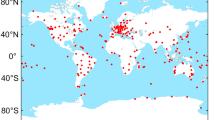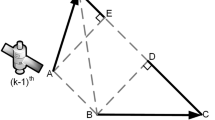Abstract
This paper investigates the problem of joint direction of departure (DOD) and direction of arrival (DOA) estimation in bistatic MIMO radar. A new bistatic MIMO array, both the transmit array and the receive array consist of two separated subarrays with dual baselines is proposed, in contrast to the modeling of both the transmit array and the receive array to be uniform linear array in the existing research literature. And a new joint DOD and DOA estimation algorithm, called unitary dual-resolution ESPRIT, is proposed. First, the short baseline rotational invariance within subarray yields non-ambiguous coarse DOD and DOA estimation. Then the long baseline rotational invariance between subarray yields high accuracy but cyclically ambiguous DOD and DOA estimation. Last, the combination of both estimates yield high accuracy and non-ambiguous DOD and DOA estimation. Moreover, we propose to utilize the properties of centro-Hermitian matrices to transform the complex-valued computations into real-valued computations throughout the whole process. The proposed algorithm gives significant improvement in DOD and DOA estimation performance, with automatic pairing and without extra antennas and computational complexity compared with the conventional algorithms. Simulation results verify the effectiveness of the proposed algorithm.











Similar content being viewed by others
References
Athley, F., & Engdahl, C. (2000). Direction-of-arrival estimation using separated subarrays. Conference Record of the Thirty-Fourth Asilomar on Signals Systems and Computers, 1, 585–589.
Bekkerman, I., & Tabrikian, J. (2006). Target detection and localization using MIMO radars and sonars. IEEE Transactions on Signal Processing, 54, 3873–3883.
Bencheikh, M. L., & Wang, Y. (2010). Joint DOD–DOA estimation using combined ESPRIT-MUSIC approach in MIMO radar. Electronics Letters, 46, 1081–1083.
Bencheikh, M. L., & Wang, Y. (2011). Combined ESPRIT-RootMUSIC for DOD–DOA estimation in polarimetric bistatic MIMO radar. Progress in Electromagnetics Research Letters, 22, 109–117.
Chen, J., Gu, H., & Su, W. (2008a). Angle estimation using ESPRIT without pairing in MIMO radar. Electronics Letters, 44, 1422–1423.
Chen, D. F., Chen, B. X., & Qin, G. D. (2008b). Angle estimation using ESPRIT in MIMO radar. Electronics Letters, 44, 770–771.
Chen, W., Xu, X., Wen, S., et al. (2011). Super-resolution direction finding with far-separated subarrays using virtual array elements. IET Radar, Sonar Navigation, 5, 824–834.
Chen, G. H., & Chen, B. X. (2012). Eigenstructure-based ambiguity resolution algorithm for distributed subarray antennas VHF radar. Electronics Letters, 48, 788–789.
Chen, H., Chen, Y., Yang, Z., et al. (2012). Extended ambiguity function for bistatic MIMO radar. Journal of Systems Engineering and Electronics, 23, 195–200.
Coutts, S., Cuomo, K., Robey, F. (2005). Distributed coherent aperture measurements for next generation BMD radar. In Proceedings of IEEE sensor array and multichannel signal process, Workshop, (pp. 390–393).
Fishler, E., Haimovich, A., Blum, R., et al. (2004). MIMO radar: An idea whose time has come. Proceedings of IEEE Radar Conference, Honolulu, Hawaii, USA, 2, 71–78.
Fishler, E., Haimovich, A., Blum, R., et al. (2006). Spatial diversity in radars-models and detection performance. IEEE Transactions on Signal Processing, 54, 823–838.
Golub, G. H., & Van Loan, C. F. (1996). Matrix computation (3rd ed.). Baltimore: The John Hopkins University Press.
Haardt, M., & Nossek, J. A. (1995). Unitary ESPRIT: How to obtain increased estimation accuracy with a reduced computational burden. IEEE Transactions on Signal Processing, 43, 1232–1242.
Haimovich, A., Blum, R., & Cimini, L. (2008). MIMO radar with widely separated antennas. IEEE Signal Processing Magazine, 25, 116–129.
Lemma, A. N., Veen, A. J., & Deprettere, E. F. (1999). Multiresolution ESPRIT algorithm. IEEE Transactions on Signal Processing, 47, 1722–1726.
Li, J., & Stoica, P. (2007). MIMO radar with colocated antennas. IEEE Signal Processing Magazine, 24, 106–114.
Liu, Z., Ruan, X., & He, J. (2013). Efficient 2-D DOA estimation for coherent sources with a sparse acoustic vector-sensor array. Multidimensional Systems and Signal Processing, 24, 105–120.
Nilsson, J.E. Warston, H. (2003). Radar with separated subarray antennas. In Proceedings of IEEE radar conference, (pp. 194–199), Australia.
Roy, R., & Kailath, T. (1989). ESPRIT-estimation of signal parameters via rotational invariance techniques. IEEE Transactions on Acoustics, Speech and Signal Processing, 37, 984–995.
Swindlehurst, A. L., Stoica, P., & Jansson, M. (2001). Exploiting arrays with multiple invariances using MUSIC and MODE. IEEE Transactions on Signal Processing, 49, 2511–2521.
Van Trees, H. L. (2002). Detection, estimation, and modulation theory, part IV: Optimum array processing. New York: Wiley.
Vasylyshyn, V. (2009). Direction of arrival estimation using ESPRIT with sparse arrays. In Proceedings of the 6th European radar conference, (pp. 246–249).
Willis, N. J. (2007). Bistatic radar (2nd ed.). Raleigh: SciTech Publishing.
Wong, K. T., & Zoltowski, M. D. (1998). Direction-finding with sparse rectangular dual-size spatial invariance array. IEEE Transactions on Aerospace and Electronic Systems, 34, 1320–1336.
Xie, R., Liu, Z., & Wu, J. X. (2012). Direction finding with automatic pairing for bistatic MIMO radar. Signal Process, 92, 198–203.
Zhang, X., & Xu, D. (2010). Angle estimation in MIMO radar using reduced-dimension Capon. Electronics Letters, 46, 860–861.
Zhang, X., Xu, L., Xu, L., et al. (2010). Direction of Departure (DOD) and Direction of Arrival (DOA) estimation in MIMO radar with reduced-dimension MUSIC. IEEE Communications Letters, 14, 1161–1163.
Zhang, S., & Zhu, X. (2013). Improved design of unimodular waveforms for MIMO radar. Multidimensional Systems and Signal Processing, 24, 447–456.
Zheng, G., Chen, B., & Yang, M. (2012). Unitary ESPRIT algorithm for bistatic MIMO radar. Electronics Letters, 48, 179–181.
Zoltowski, M. D., Haardt, M., & Mathews, C. P. (1996). Closed-form 2-angle estimation with rectangular arrays in element space or beamspace via unitary ESPRIT. IEEE Transactions on Signal Processing, 44, 316–328.
Acknowledgments
The authors would like to thank the anonymous reviewers and the Editor for their valuable comments and suggestions, which have greatly improved the quality of this paper. This work is supported by National Natural Science Foundation of China (61001209, 61101244), Program for Changjiang Scholars and Innovative Research Team in University IRT0954 and the Fundamental research Funds for the Central Universities (K5051202038).
Author information
Authors and Affiliations
Corresponding author
Rights and permissions
About this article
Cite this article
Zheng, G., Chen, B. Unitary dual-resolution ESPRIT for joint DOD and DOA estimation in bistatic MIMO radar. Multidim Syst Sign Process 26, 159–178 (2015). https://doi.org/10.1007/s11045-013-0244-5
Received:
Revised:
Accepted:
Published:
Issue Date:
DOI: https://doi.org/10.1007/s11045-013-0244-5




